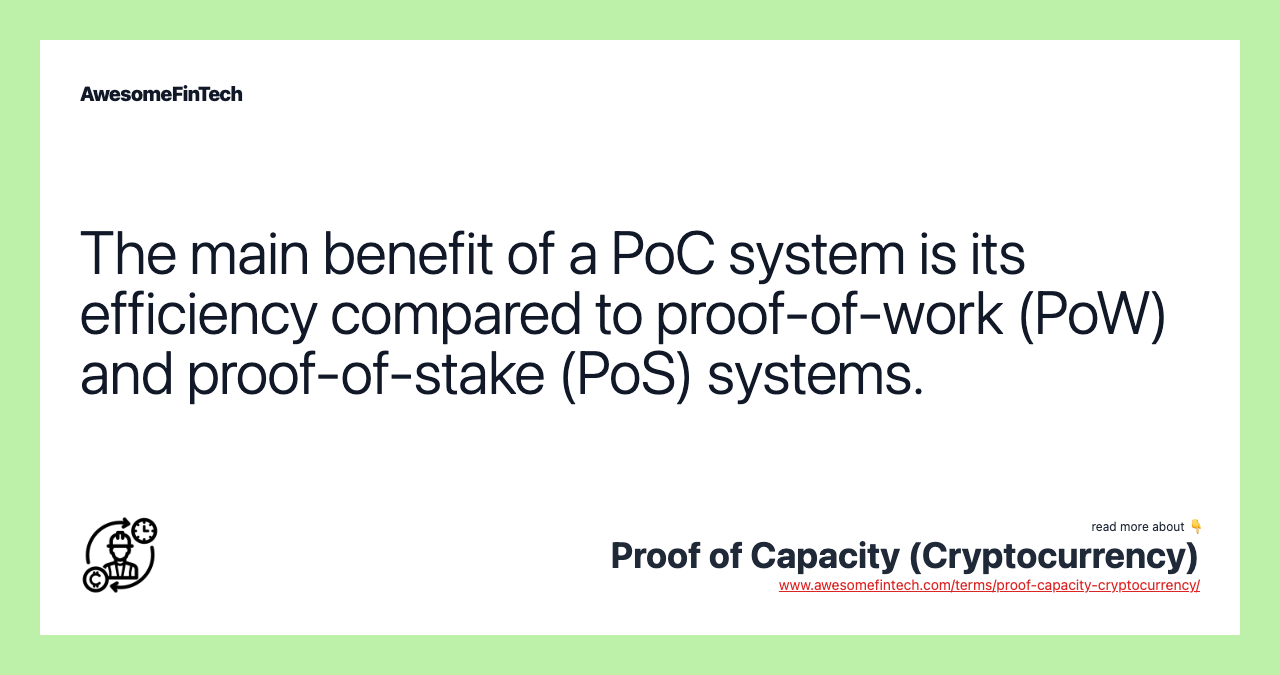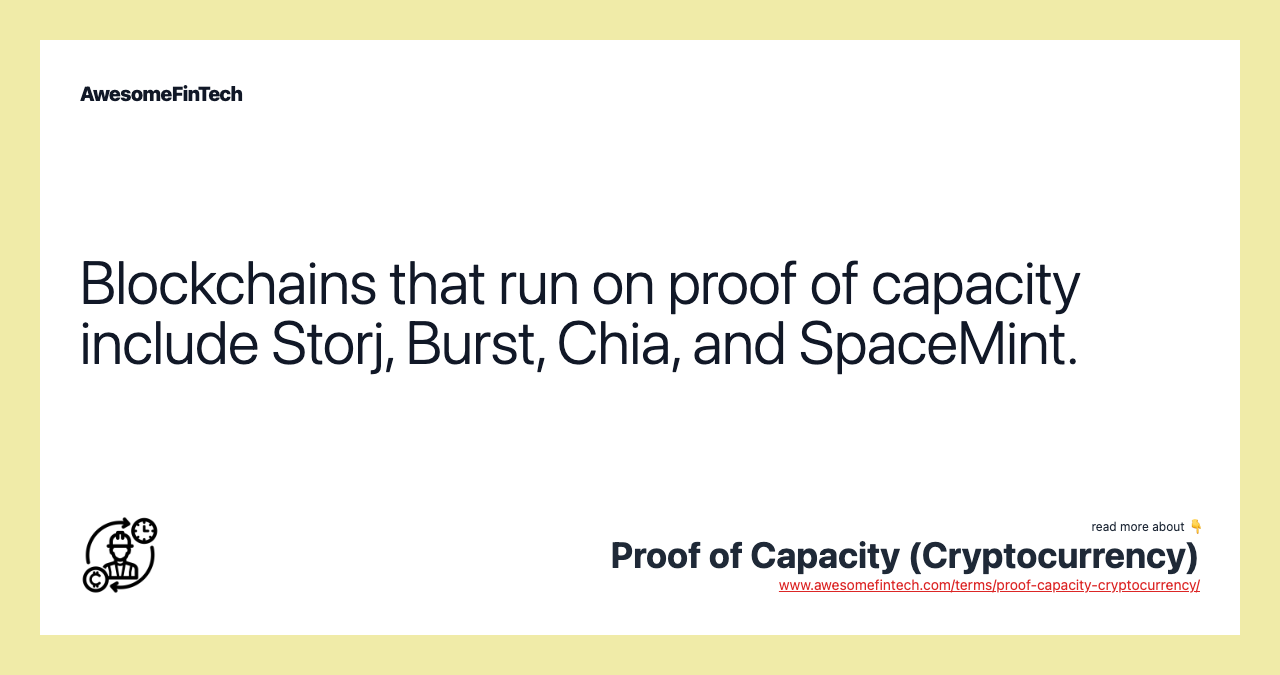Proof of Capacity (Cryptocurrency)
Proof of capacity (PoC) is a consensus mechanism algorithm used in blockchains that allows for mining devices in the network to use their available hard drive space to decide mining rights and validate transactions. This is in contrast to using the mining device’s computational power (as in the proof of work algorithm) or the miner’s stake in the cryptocurrencies (as in the proof of stake algorithm). Proof of capacity (PoC) authentication systems employ spare space on a device's hard drive to store solutions to a cryptocurrency hashing problem. Instead of repeatedly altering the numbers in the block header and repeated hashing for the solution value as in a PoW system, PoC works by storing a list of possible solutions on the mining device’s hard drive even before the mining activity commences. The larger the hard drive, the more possible solution values one can store on the hard drive, the more chances a miner has to match the required hash value from his list, resulting in more chances to win the mining reward. Proof of capacity (PoC) is a consensus mechanism algorithm used in blockchains that allows for mining devices in the network to use their available hard drive space to decide mining rights and validate transactions.

What Is Proof of Capacity (PoC) for Cryptocurrencies?
Proof of capacity (PoC) is a consensus mechanism algorithm used in blockchains that allows for mining devices in the network to use their available hard drive space to decide mining rights and validate transactions. This is in contrast to using the mining device’s computational power (as in the proof of work algorithm) or the miner’s stake in the cryptocurrencies (as in the proof of stake algorithm).



Understanding Proof of Capacity
Proof of capacity emerged as one of the many alternative solutions to the problem of high energy consumption in proof of work (PoW) systems and cryptocurrency hoarding in proof of stake (PoS) systems.
Proof of capacity allows the mining devices, also known as nodes, on the blockchain network to use empty space on their hard drive to mine the available cryptocurrencies.
Instead of repeatedly altering the numbers in the block header and repeated hashing for the solution value as in a PoW system, PoC works by storing a list of possible solutions on the mining device’s hard drive even before the mining activity commences.
The larger the hard drive, the more possible solution values one can store on the hard drive, the more chances a miner has to match the required hash value from his list, resulting in more chances to win the mining reward.
To draw an analogy, if lottery rewards are based on matching the most numbers on the winning ticket, then a player with a longer list of possible solutions will have better chances of winning. Additionally, the player is allowed to keep using the lottery ticket block numbers again and again repeatedly.
Burstcoin is a cryptocurrency that uses a proof of capacity system. Other coins that use it are Storj, Chia, and SpaceMint.
How PoC Works: Plotting and Mining
The proof-of-capacity protocol involves a two-step process that involves plotting and mining.
First, the hard drive is plotted: the list of all possible nonce values are created through repeated hashing of data, including a miner’s account. Each such nonce contains 8192 hashes, which are numbered from 0 to 8191. All the hashes are paired into "scoops," which means adjacent hashes are combined to form a pair of two. For instance, hash 0 and 1 constitute scoop 0, hash 2 and 3 constitute hash 1, and so on.
The second step involves the actual mining exercise, during which a miner calculates a scoop number. For instance, if a miner begins the mining activity and generates a scoop number 38, the miner would then go to scoop number 38 of nonce 1 and use that scoop’s data to calculate a deadline value.
The process is repeated for calculating the deadline for each nonce held upon on the miner’s hard drive. Following the calculation of all the deadlines, the one with the minimum deadline is selected by the miner.
A deadline represents the duration of time in seconds that must elapse since the last block was forged before a miner is allowed to forge a new block. If no one else has forged a block within this time, the miner can forge a block and claim the block reward.
For instance, if miner X comes up with a minimum deadline of 36 seconds and no other miners can forge the block within the next 36 seconds, X will secure the chance to forge the next block and get rewarded.
Pros and Cons of Proof of Capacity
PoC has several advantages over PoW and PoS systems, as well as some important disadvantages that include:
Related terms:
Bitcoin Mining : Is It Still Profitable?
Breaking down everything you need to know about Bitcoin mining, from blockchain and block rewards to proof of work and mining pools. read more
Blockchain : What You Need to Know
A guide to help you understand what blockchain is and how it can be used by industries. You've probably encountered a definition like this: “blockchain is a distributed, decentralized, public ledger." But blockchain is easier to understand than it sounds. read more
Burstcoin (BURST)
Burstcoin (BURST) is a cryptocurrency that supports smart contracts and digital assets and uses an energy-efficient proof-of-capacity mining algorithm read more
Consensus Mechanism (Cryptocurrency)
Amid the dynamically changing status of the blockchain, a consensus mechanism ensures that only the true state of the system is maintained. read more
Cryptocurrency : What Is Cryptocurrency?
A cryptocurrency is a digital or virtual currency that uses cryptography and is difficult to counterfeit because of this security feature. read more
Nonce
In blockchain technology, nonce means a number added to a hashed, or encrypted block, that, when rehashed, meets the difficulty level restrictions. Blockchain miners aim to solve the nonce. read more
Proof of Activity
Proof of activity is the blockchain consensus algorithm based on a hybrid approach. read more
Proof of Burn (Cryptocurrency)
The proof of burn (POB) consensus algorithm combines the proof of work (POW) and proof of stake (POS) and partially overcomes their shortcomings. read more
Proof of Stake (PoS)
Proof of Stake (PoS) concept states that a person can mine or validate block transactions according to how many coins they hold. read more
Proof of Work (PoW)
Proof of work describes the process that allows the bitcoin network to remain robust by making the process of mining, or recording transactions, difficult. read more